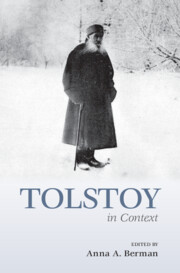Book contents
- Tolstoy in Context
- Tolstoy in Context
- Copyright page
- Contents
- Figures
- Notes on Contributors
- Preface
- Acknowledgments
- Note on Citations, Translations, and Transliterations
- Chronology
- Part I The Man
- Part II Russian Social and Political Contexts
- Part III Literature, the Arts, and Intellectual Life
- Chapter 16 Tolstoy’s Oeuvre
- Chapter 17 Peasant Schools and Education
- Chapter 18 Russian Philosophy
- Chapter 19 The Russian Literary Scene
- Chapter 20 European Literature
- Chapter 21 European Philosophy
- Chapter 22 Theater
- Chapter 23 Music
- Chapter 24 The Visual Arts
- Part IV Science and Technology
- Part V Beyond Russia
- Part VI Tolstoy’s Afterlife
- Suggested Further Reading
- Index
Chapter 16 - Tolstoy’s Oeuvre
from Part III - Literature, the Arts, and Intellectual Life
Published online by Cambridge University Press: 05 January 2023
- Tolstoy in Context
- Tolstoy in Context
- Copyright page
- Contents
- Figures
- Notes on Contributors
- Preface
- Acknowledgments
- Note on Citations, Translations, and Transliterations
- Chronology
- Part I The Man
- Part II Russian Social and Political Contexts
- Part III Literature, the Arts, and Intellectual Life
- Chapter 16 Tolstoy’s Oeuvre
- Chapter 17 Peasant Schools and Education
- Chapter 18 Russian Philosophy
- Chapter 19 The Russian Literary Scene
- Chapter 20 European Literature
- Chapter 21 European Philosophy
- Chapter 22 Theater
- Chapter 23 Music
- Chapter 24 The Visual Arts
- Part IV Science and Technology
- Part V Beyond Russia
- Part VI Tolstoy’s Afterlife
- Suggested Further Reading
- Index
Summary
This chapter sketches the shape of Tolstoy’s oeuvre by focusing on a key text from each decade of his long and varied career. In Childhood (1852), his first published work, Tolstoy had already begun both to draw upon and to distrust the powers of realist fiction. This tension is palpable in his great novels War and Peace (1865–9) and Anna Karenina (1875–8), and it motivated his sporadic turns away from artistic literature during the years he was writing them. Confession (1879–82), which marked the most dramatic of these crises, is a conversion narrative that ends with a call to rethink the edifice of Christianity. In the second half of his life he pursued this task in a range of genres. Lavishing his gift for evocative description on polemical accounts of social atrocities, in his fiction he now reached for emblematic universality. The Death of Ivan Ilyich (1886), a celebrated short story, and “The First Step” (1892), a treatise on vegetarianism, exemplify these divergent styles. However, they stirringly reconverge in posthumously published works like the historical novella Hadji Murat (1896–1904), where Tolstoy represented escape from the mortal body in paradoxically vivid realist detail.
Keywords
- Type
- Chapter
- Information
- Tolstoy in Context , pp. 129 - 135Publisher: Cambridge University PressPrint publication year: 2022

